Blog, Industry News, trenchless projects
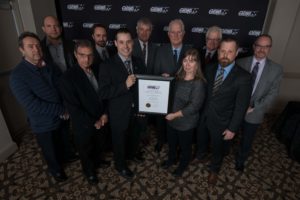 The Ontario Public Works Association (OPWA) 2016 Project of the Year: Environment, Greater than $50 Million Category was awarded to project owner, Regional Municipality of Halton along with lead consultant, Dillon Consulting Limited, consultant, R.V. Anderson and contractors; Dibco Underground Ltd and Varcon Construction Corporation for the Boyne Trunk Sanitary Sewer project. The awards luncheon was held on January 26 during the 2017 OPWA Annual Conference.
The Ontario Public Works Association (OPWA) 2016 Project of the Year: Environment, Greater than $50 Million Category was awarded to project owner, Regional Municipality of Halton along with lead consultant, Dillon Consulting Limited, consultant, R.V. Anderson and contractors; Dibco Underground Ltd and Varcon Construction Corporation for the Boyne Trunk Sanitary Sewer project. The awards luncheon was held on January 26 during the 2017 OPWA Annual Conference.
The South Halton Water and Wastewater Master Plan Update identified the need for a trunk sanitary sewer that could provide service for approved growth and future development within the Halton region. Dillon has been assisting Halton with contract administration and field services during construction starting in January of 2014 through July of 2016.
Congratulations to Halton Region Project Manager and NASTT Board Member, Brenda Kingsmill, and the rest of the crew on the success of such a large undertaking!
Blog, trenchless people, trenchless projects
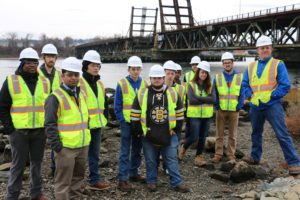 Recently, 12 students from NASTT’s Student Chapter at UMASS Lowell attended a Horizontal Directional Drilling (HDD) site visit on location with Liberty Utilities in Somerset, Massachusetts. The students observed an HDD river crossing project. A safety briefing was held and all the necessary PPE was donned prior to the students entering the job site.
Recently, 12 students from NASTT’s Student Chapter at UMASS Lowell attended a Horizontal Directional Drilling (HDD) site visit on location with Liberty Utilities in Somerset, Massachusetts. The students observed an HDD river crossing project. A safety briefing was held and all the necessary PPE was donned prior to the students entering the job site.
Everyone in attendance thoroughly enjoyed the visit and found it to be very educational on the HDD process and how trenchless technology is used in utility work.
Many thanks to Liberty Utilities for hosting the students and helping to educate the future of trenchless!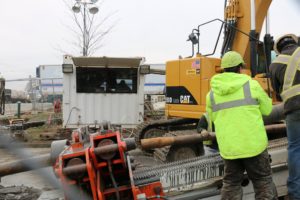
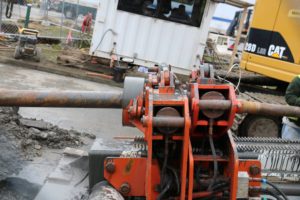
Blog, trenchless products
Showcasing DTH Hammers & Bits in Central Hall 3-5 Booth C31610
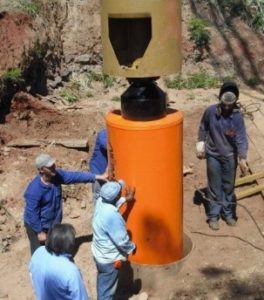 THOMPSON, CONNECTICUT USA, January 18, 2017 – Numa, the world’s leading designer and manufacturer of down hole hammers and bits, will be attending CONEXPO-CON/AGG 2017 taking place in Las Vegas, Nevada March 7 – 11, 2017. Numa will be located in Central Hall 3-5 Booth C31610 with experienced staff on hand to meet with current and prospective customers and partners.
THOMPSON, CONNECTICUT USA, January 18, 2017 – Numa, the world’s leading designer and manufacturer of down hole hammers and bits, will be attending CONEXPO-CON/AGG 2017 taking place in Las Vegas, Nevada March 7 – 11, 2017. Numa will be located in Central Hall 3-5 Booth C31610 with experienced staff on hand to meet with current and prospective customers and partners.
Numa will display a full range of DTH hammers and bits for drilling holes 3-1/2” to 48” (89 – 1219 mm) in diameter. Numa’s DTH products have proven to outdistance competitive hammers and bits in speed and longevity with each model designed for specific types of applications. This gives drillers the ultimate flexibility in product offering. A cutaway hammer will be on hand to provide attendees with the ability to see internal DTH hammer components and how it operates down the hole.
Also exhibited will be Numa’s Super Jaws® Overburden Bits. Super Jaws provides dependable performance and longevity for simultaneously drilling and casing holes in unconsolidated ground conditions of overburden, boulders, or bedrock. With its unique wing design, Super Jaws retracts back into the guide body when drilling is complete for extraction of all tooling while leaving the casing in place. There is no reverse rotation required, nor any expensive rings, saving drillers time and money. Super Jaws is capable of drilling hole sizes 5 ½” to 42” (139 – 1067 mm) in diameter.
Super Jaws is available in two versions. One version utilizes a drive shoe welded to the front of the casing. As the bit advances, the casing is advanced at the same rate due to the drive shoulder on the guide body contacting the drive shoe welded to the casing. The Super Jaws ND version allows the use of thick wall casing or thick wall threaded casing. The guide body has no drive shoulder and the casing is advanced via a casing hammer, duplex diverter, or dual rotary.
Stop by to visit Numa in Central Hall 3-5 Booth C31610.
ABOUT NUMA
Numa is the world’s leading designer of rock drilling equipment with over 100 DTH Hammer and Bit products serving 11 different industries. Our products are capable of drilling vertical, horizontal, and reverse circulation holes from 3½ to 48 inches (89 – 1219 mm) in diameter and are used in 105+ countries. We have built our customer-centric reputation on providing the highest value in products, performance and personal service available in the rock drilling industry.
Blog, Industry News, trenchless projects
Rock Machine surmounts challenges on High-Cover Los Condores HEPP
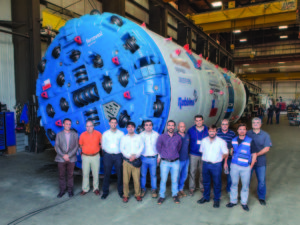
Project officials and Robbins team members celebrate the impending launch of the Double Shield TBM on 10.4 km (6.4 mi) of tunnels for the Los Condores Hydroelectric Project.
Chile’s Los Condores HEPP is a high cover, hard rock challenge, with 500 m (1,640 ft) of rock above the tunnel and a high-altitude jobsite 2,500 m (8,200 ft) above sea level. As of January 2017, a 4.56 m (15.0 ft) Robbins Double Shield TBM had completed boring its 900 m (2,950 ft) long access tunnel and was well on the way to boring the first section of headrace tunnel. The machine embarked on its journey on May 27, 2016, and has since excavated over 1,300 m (4,270 ft) of tunnel in total.
The journey to machine launch was an arduous one, requiring shipment of TBM components and vehicle transport on unpaved, mountainous roads. Contractor Ferrovial Agroman is responsible for the intake tunnel at the Los Condores Hydroelectric Project, and was well aware of the challenges associated with machine launch: “The location of the work is a big constraint due to its rugged terrain and geographical location in the Andes. With all this, we are anxious to perform work in an efficient manner,” said Pello Idigoras, Tunnel Production Manager for Ferrovial Agroman.
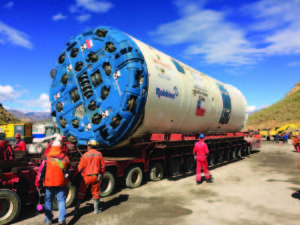
As of January 2017 the Robbins TBM had completed the 900 m (2,950 ft) long access tunnel and was boring its first section of headrace tunnel at rates of up to 25 rings per day.
The jobsite, located 360 km (224 mi) south of Santiago, Chile, is part of a new 150 MW power plant and intake tunnel. The Robbins Double Shield TBM is boring two sections of the intake tunnel, the first measuring 6 km (3.7 mi) and the second measuring 4.4 km (2.7 mi). A section between the two tunnels will be excavated by drill and blast to connect them, making the intake tunnel about 12 km (7.5 mi) in length. “This project brings an increase in energy production in the country, thus contributing to the overall improvement in the welfare of its citizens,” said Idigoras of the effect the completed hydropower project will have on surrounding areas.
The tunnel, located in the mountainous Maule Region of Chile, is being bored in two types of rock: sedimentary and volcanic. The rock has been tested at strengths up to 100 MPa (14,500 psi) UCS, with at least two fault zones—the first of which has already been traversed in rhyolite, andesite, tuff, and breccia. For Idigoras, the conditions are well-suited to Double Shield tunneling: “We have good quality medium to hard rock for Double Shield excavation overall,” he said. Despite that, some areas of challenging ground persist. To cope with the conditions, including steadily increasing water inflows at rates of up to 3,500 l/min (925 gal/min), the contractor is utilizing cementitious grouting and chemical grouting with polyurethane and foam. Such ground conditioning techniques were anticipated and the Robbins Double shield was designed to effectively apply these techniques.
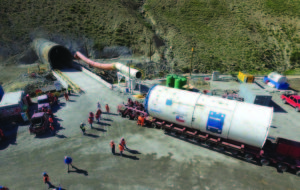
The challenging launch of the Robbins TBM at the remote jobsite 2,500 m (8,200 ft) above sea level.
As the TBM excavates, it is lining the tunnel with 250 mm (10 in) thick, 1.2 m (3.9 ft) long concrete segments in a 4+1 arrangement. The machine is currently progressing at a rate of up to 25 rings per 20 hours of boring. Crews are operating in two 10-hour shifts with one 4-hour shift dedicated to maintenance. Idigoras sees the TBM performance and completion of the access tunnel as huge project milestones, though much work remains to be done. “After many months working in engineering, manufacturing, installation, and commissioning, we are proud to see this result. It would be impossible to name all the people who participated in this project thus far but they, as a whole, have managed to get the TBM started digging and boring well.”
Blog, Industry News
 You are invited to submit a paper for the ASTT’s 12th No-Dig Down Under Conference and Exhibition, which will be held on the Gold Coast from 12-15 September 2017.
You are invited to submit a paper for the ASTT’s 12th No-Dig Down Under Conference and Exhibition, which will be held on the Gold Coast from 12-15 September 2017.
Share your knowledge and experiences with Australasia’s Trenchless Technology leaders.
The Call for Papers closes on Wednesday 15 March 2017. All eligible abstracts will be reviewed by a program committee for inclusion in the final conference program.
Papers covering any of the following topics are welcome:
- horizontal directional drilling (HDD)
- pipe jacking
- microtunnelling
- pipe ramming
- design
- training
- new technology and equipment
- cured in place pipe (CIPP)
- grouting
- slip lining and spray lining
- spiral wound pipe
- training
- new technology and equipment
- utility location.
Submit your paper online today!
Abstracts should be:
- In English
- Relevant to the themes of the event
- Accompanied with a biography on the presenter
For more information visit the event website: www.nodigdownunder.com
Blog, Industry News, trenchless products
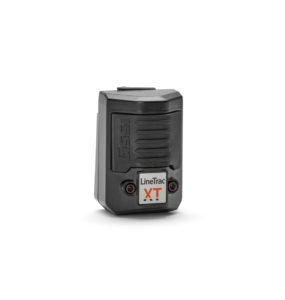 GSSI, the world’s leading manufacturer of ground penetrating radar (GPR) equipment, announces the availability of LineTrac™ XT, an accessory to the StructureScan Mini XT. The combination of the StructureScan Mini XT and LineTrac XT helps concrete professionals locate specific power sources in concrete, including AC power and induced RF energy present in conduits. The new LineTrac XT accessory combines radar data with a magnetometer, delivering accurate, dependable, and repeatable performance.
GSSI, the world’s leading manufacturer of ground penetrating radar (GPR) equipment, announces the availability of LineTrac™ XT, an accessory to the StructureScan Mini XT. The combination of the StructureScan Mini XT and LineTrac XT helps concrete professionals locate specific power sources in concrete, including AC power and induced RF energy present in conduits. The new LineTrac XT accessory combines radar data with a magnetometer, delivering accurate, dependable, and repeatable performance.
LineTrac XT includes a number of features that make it easy to identify target utilities, including easy integration with StructureScan Mini XT, seamless data fusion with GPR data, a 50/60 Hertz (Hz) electro-magnetic sensor used to locate powered conduits, and a rugged, IP-65 rated enclosure. LineTrac XT detects extremely low amplitude AC signals associated with difficult to locate conduits. The LineTrac XT accessory complies with all applicable FCC, RSS, RoHS, and CE requirements. It can operate in temperatures ranging from 20°C to 40°C (14°F to 122°F).
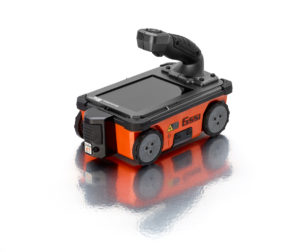 The StructureScan Mini XT now comes equipped with the LineTrac XT software package. Users simply insert the LineTrac XT into the front accessory port, select the LineTrac XT module, and choose between 50 Hz or 60 Hz.
The StructureScan Mini XT now comes equipped with the LineTrac XT software package. Users simply insert the LineTrac XT into the front accessory port, select the LineTrac XT module, and choose between 50 Hz or 60 Hz.
About GSSI
Geophysical Survey Systems, Inc. is the world leader in the development, manufacture, and sale of ground penetrating radar (GPR) equipment, primarily for the concrete inspection, utility mapping and locating, road and bridge deck evaluation, geophysics, and archaeology markets. Our equipment is used all over the world to explore the subsurface of the earth and to inspect infrastructure systems non-destructively. GSSI created the first commercial GPR system nearly 45 years ago and continues to provide the widest range and highest quality GPR equipment available today.
 The Ontario Public Works Association (OPWA) 2016 Project of the Year: Environment, Greater than $50 Million Category was awarded to project owner, Regional Municipality of Halton along with lead consultant, Dillon Consulting Limited, consultant, R.V. Anderson and contractors; Dibco Underground Ltd and Varcon Construction Corporation for the Boyne Trunk Sanitary Sewer project. The awards luncheon was held on January 26 during the 2017 OPWA Annual Conference.
The Ontario Public Works Association (OPWA) 2016 Project of the Year: Environment, Greater than $50 Million Category was awarded to project owner, Regional Municipality of Halton along with lead consultant, Dillon Consulting Limited, consultant, R.V. Anderson and contractors; Dibco Underground Ltd and Varcon Construction Corporation for the Boyne Trunk Sanitary Sewer project. The awards luncheon was held on January 26 during the 2017 OPWA Annual Conference.









